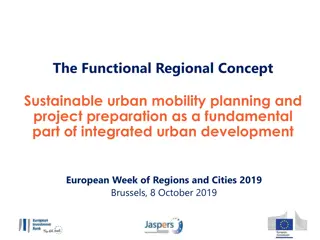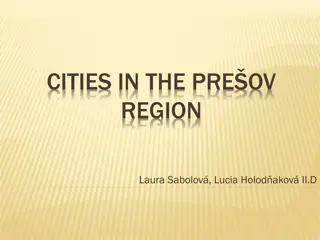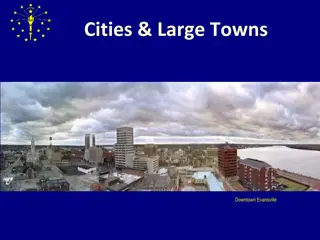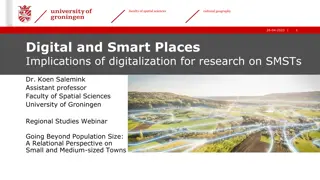Functional Classification of Towns Based on Economic Functions
Geographers classify towns based on functions they perform, focusing on economic functions like trade, administration, defense, and entertainment. Techniques such as statistical analysis help identify the main functions objectively. Each town has a dominant function, influencing its role within urban systems and distinct characteristics. The classification is crucial for urban planning and understanding town dynamics.
Download Presentation

Please find below an Image/Link to download the presentation.
The content on the website is provided AS IS for your information and personal use only. It may not be sold, licensed, or shared on other websites without obtaining consent from the author. Download presentation by click this link. If you encounter any issues during the download, it is possible that the publisher has removed the file from their server.
E N D
Presentation Transcript
II M.Sc. APPLIED GEOGRAPHY GOVERNMENT COLLEGE FOR WOMEN (A) KUMBAKONAM POPULATION AND SETTLEMENT GEOGRAPHY TITLE : FUNCTIONAL CLASSIFICATION OF TOWNS TITLE : FUNCTIONAL CLASSIFICATION OF TOWNS 28.10.2020 & 04.11.2020 28.10.2020 & 04.11.2020 PRESENTED BY S. MAHESWARI GUEST LECTURER IN GEOGRAPHY
FUNCTIONAL CLASSIFICATION OF TOWNS FUNCTIONAL CLASSIFICATION OF TOWNS The definition of function varies across the disciplines. In political science it refers to duties, in mathematics it means the relationship between two variables and in geography it is synonymous to occupation. Geographers have classified towns on the basis of their site, situation, size, rank, location and relative elevation. A more useful classification of towns and cities is on the basis of functions they perform. This categorization is also known as the functional classification of towns. Functional classification of towns attempts to categorize towns and cities according to their economic functions, thereby identifying their roles within classifications use employment and occupational data. urban systems. Most
Such data are processed by applying simple and sophis- ticated statistical techniques, such as standard deviation and principal component analysis. These techniques help in ascertaining the main functions of the towns under study on an objective basis. A common characteristic of all the towns and cities is that they are trading and have business centres. But most cities and towns perform additional functions also which give them distinctive characteristics. Towns are therefore classified according to their dominant function. This dominant function may be trade, administration, defence or entertainment.
Towns have been examined from the origin, site, and situation, morphological and functional points of view. One of the aspects on which geographers are increasingly focusing their attention is the functional aspect. In functional classification of towns, attempts are being made to categorize towns and cities according to their economic functions. The main objective of functional classification of towns is to identify their roles within urban systems. Most of the classifications of towns have been done on the basis of primary or secondary data pertaining to occupations. Simple and sophisticated techniques have been used to delineate and classify towns on the basis of functions.
In reality, each town has the dominance of some function and any change in the function may change the importance of certain lavational advantages. All towns perform trading functions of one sort or another, but most towns also have additional functions which give them distinctive characteristics. In the functional classification approach, towns are classified on the basis of their dominant function. The functional classification of towns has been illustrated in the following
1. Administrative Towns: The main function of administrative cities and towns is to administer the country/state or a specific territory. It includes not only the capital cities of countries, but all the centres of provinces, states, districts and other administrative divisions of the country. There are quite large administrative cities, some of them as mega cities such as Tokyo (2.7 million), Mexico City (16.6 million), Buenos Aires (11.8 million), Seoul (11.6 million), Beijing (11.3 million), Cairo (9.7 million), Jakarta (8.6 million), Paris (8.5 million), New Delhi (10.2 million) and London (7.4 million). There are several province capitals also which have more than several millions of population. In India, Mumbai, Chennai, Hyderabad, Luck now and Jaipur are some of the examples of such administrative
There are numerous small-sized administrative towns (capitals) such as male, capital of Maldiev (40,000), Stanley, capital of Falkland with a population of only one thousand, and Monaco (29,000). In India, Kohima (60,650) and Itanagar (20,500) are the administrative towns with less than one lakh population each. Apart from old capitals and homes of the ruling families, there are many capitals which have been newiy created for historical, political and strategic reasons. Islamabad in Pakistan, Ottawa in Canada, Brasilia in Brazil and Canberra in Australia are the examples of such capitals. After the partition of the sub-continent of India, Chandigarh was planned as the capital of East Punjab (India) and later on it became the capital of Punjab, Haryana and the Union Territory of Chandigarh.
The basic function of the administrative towns is the public administration. administrative cities contain government offices, public buildings, royal palaces and residences of president, prime minister, ministers, bureaucrats officers. These are usually the organizations such as banks, post offices, railways, defence, trade and industries. The capitals also have universities, hospitals and headquarters of political parties. The concentration of public buildings, parks and sporting facilities tends to make capitals tourist centres, especially royal palaces, mosques, cathedrals, churches, temples and other Consequently, all the and other headquarters of state-run
2. Defensive Towns: During the medieval period, most of the towns and cities used to be developed on the defensive sites. Forts and garrisons used to be constructed at strategic places. The defensive towns have barracks, cantonments, and training facilities for the armed forces, airfields, and harbours for warships. Visakhapatnam, MHOW and Khadakwasla (India); Peshawar (Pakistan); Playmouth and Portsmouth (England); and Halifax and Nova Scotia (Canada) have been developed as the defensive towns. In many garrison and defensive towns, there is a clear division of land use between the civil and military authorities, so that the military installations are often at a little distance from the town or are grouped together in one part of the town. This is necessary to maintain security, though often many town people
The city of Meerut and its cantonment, the city of Roorkee and its cantonment and similarly numerous other military and defensive towns have the civil and military components adjacent to each other. 3. Cultural Centres: There are numerous towns and cities in the world, almost in each of the countries, which perform cultural functions. The cities of Oxford and Cambridge in England are the most suitable examples of educational towns. In these towns, one may find colleges, churches, playgrounds, parks and shopping centres. The environmental pollution in these towns is almost insignificant libraries, hostels,
The cities of Harvard (USA), Heidelberg (Germany), Leiden (the Netherlands), and Aligarh, Varanasi, Pilani, Pantnagar and Roorkee (India) are also the good examples of educational towns. The university is sometimes mingled with the town but in every university town the campus is often on the outskirts of the town. There are numerous religious centres. These religious towns may be the seats of religious leaders (e.g., the Vatican City, Rome, the residence of Pope; or Lhasa, once the seat of the Dalai Lama of Tibet). These religious centres may be centres of pilgrimage, such as Jerusalem, Mecca, Medina, Badrinath, etc. Towns where religion is important have many religious buildings, shops selling religious books, flowers, joss sticks, etc. They also provide accommodation for pilgrims and often have Karbala, Hardwar, Triputi,
Moreover, entertainment birthplace of William Shakespeare (England), Hollywood (California) and Cannes (France) are some of the examples of such towns. 4. Collection Centres: The mining towns, fishing ports and lumbering centres fall under the category of collection centres/towns. There are numerous metallic, non-metallics, precious stones and energy resources which are obtained from mines. The towns which serve these mines may be small settlements serving a particular mine such as Zawar near Udaipur (Rajasthan), Bjiladela (Madhya Pradesh) and Digboi (Assam) there are many towns Stratford-on-Avon, which perform functions. the
They may be large in size such as Raniganj, Hazaribagh (Bihar), Ipoh in the tin rich Kinta valley of Malaysia, or Kuwait and Abadan in the oil producing regions of Kuwait and Tehran, respectively. Such towns may have some industries related to the mineral mines, such as smelters and refineries. The shops in such towns sell mining equipments and special clothes needed for miners. Fishing ports are the base for small boats which go to sea every day or may be used by large vessels which stay at sea for days or weeks, but they have many features in common. They are usually grouped fairly closely around the harbour and have facilities of landing, storing, cleaning, drying, packing and dispatching the fish, as well as canneries, fertilizer plants, fish meal plants or freezing plants in some cases.
In many fishing ports, other related activities such as boat building, net making or repairing and fishing equipment are also found. The main functions of lumbering towns are to collect and partly process the wood and they often have saw mills and joinery. Some may also have plants for making pulp and paper. The timber towns of Kahgodam (Uttranchal), Kotdwar (Uttar Pradesh), Dimapur (Malaysia), New Foundland and Grand Falls (Canada) are the examples of lumbering towns. Apart from the saw and paper mills, the lumbering towns have tree nurseries and research centres. (Nagaland), Sabah
5. Production Centres: Urban places, town and cities in which some kind of manufacturing industry is the major function is known as a production centre. The size and appearance of the town are affected by the type of industry located there. For example, Jamshedpur, Dhanbad and Bhadravati in Magnitogorsk in Russia and Birmingham in UK are dominated by large steel plants. Such iron and steel producing towns are generally located near the coal fields. For the manufacturing towns, transportation is very important for the transport of raw materials and the finished goods. These days such towns are generally set up on lines of communication. Rourkela, India, Bhilai, Pittsburgh Durgapur, in USA, as collecting centres,
In Japan, there are such towns between Tokyo and Osaka. In India, Rourkela, Bhilai, Dhanbad and Durgapur are also on the main lines of transportation and communication. In manufacturing towns, there is a segregation of houses and establishments; the officer s quarters may be grouped at one place and that of the labourers at the other. Birmingham (iron and steel) in England, Rochester and Detroit (iron and car manufacturing) in America and Ahmadabad and Surat (textile manufacturing) in India are some of the examples of manufacturing towns. These towns may specialize in one or in several industries
6. Transfer and Distribution Centres: The main functions performed at transfer centres are the trade, commerce and services. Towns which are concerned with the transfer and distribution of goods, however, have trade as their major function. They include several types of towns. For example, market towns, sea ports and financial towns. Market towns are characterized by markets, a wide range of shops, stores, warehouses, wholesale .markets. Market towns also have banks, insurance companies and other financial organizations. Kanpur, Ahmedabad, Vadodara, Indore, Bhopal, Patna, Lucknow, Ludhiana and Hapur in India, Norwich in England, Alexandria in Egypt, and Kumasi in Ghana are some of the examples of such towns. godowns, cold storages and
The most important trading and distribution centres are generally the ports. Moreover, most of the largest cities of the world are sea ports. Tokyo, Sao Paulo, New York, Shanghai, Mumbai, Los Angeles, Buenos Aires, Kolkata and Rio de Janeiro are all important sea ports and have more than five million populations each. There are many important inland ports on lakes and rivers including Kolkata on the Hooghly River, Hankow on Yangtze Kiang, St. Louis on the Mississippi, and Baku on the bank of Caspian Sea and Cleveland on Lake Erie. Apart from the infrastructure for trade, they have large commercial sectors with shops, offices and financial institutions. There is a high degree of diversity in the functions performed by different ports. For example, there are general ports (Hamburg, Marseilles, Bandar Abbas, Karachi, Colombo, Malacca, Lobito, etc.), passenger ports such as Kingston 0amaica) and Jeddah (Saudi Arabia), out ports (Hamburg Avon, London) and entrepot ports (Rotterdam, Aden, Singapore). The entrepot ports are characterized with large warehouse facilities and shipping and trading companies.
In some of the towns, the dominant function is finance rather than trade or distribution of goods. Such towns include Frankfurt in Germany, Zurich in Switzerland, Amsterdam in the Netherlands, Beirut in Lebnon and Wall Street in New York. These towns and cities have stock markets, auction rooms, and numerous offices, financial houses, banks and commercial agencies. 7. Resorts: The urban places which cater to the recreation needs of people are known as resorts or recreation towns. These urban places may be based on health-giving water (hot springs), seaside recreation, attractions, historical monuments, sports facilities, national parks and attractive scenery. mountain climbing, cultural
Resorts accommodate visitors, and also provide sporting facilities such as golf courses, swimming pools, trekking and skiing. Moreover, they have numerous entertainment facilities, such as theatres, cinemas, and night clubs and children parks. They also have a good range of shopping facilities as most tourists like to buy souvenirs, postcards, and clothing and equipment for the sporting activities. The old-age people also prefer to stay there to pass their retired life. In some British seaside resorts, almost half of the population is over 65 years of age. Dehradun is also known as the town of retired officers. and recreational towns have many hotels to
Srinagar, Gulmarg, Pahalgam, Sonmarg (Kashmir), Shimla, Dalhousie, Kulu, Manali (Himachal Pradesh), Mussoorie, Nainital, Ranikhet (Uttranchal), Mt. Abu (Rajasthan) and Darjeeling (West Bengal) are some of the examples of such towns in India. Moritz (Switzerland), Trieste. Padova (Italy), Gulu (Uganda), Wajir (Kenya), Murrie Mardan (Pakistan), Swansea (Wales), Aberdeen and Dundee (Scotland), and Samarkand, Bukhara and Khiva (Uzbekistan) are some of the examples of such towns.
8. Residential Towns: In some towns, the chief function is simply to house a concentration of population. In such areas, most of the land is devoted to houses, parks and hospitals. These towns are very- well-connected with the major cities, which enables the commuters to get to work each day. Shahdara, Sahibabad, Ghaziabad, Shakarpur, Ghazipur, Khichripur, Bahadurgarh, Sanpla, Gurgaon, Sohna and Badarpur are such towns situated around Delhi. In fact, the towns which fall in this category are the suburbs, and small towns and villages around the metropolitan cities.
9. Towns of Diversified Functions: As stated at the outset, towns are classified according to their major functions. So, all those towns (such as Mumbai, Kolkata, Chennai, etc.) can be put into a definite category in which a large number of activities are conducted. Such towns are referred as diversified in functions. Over space and time, the functions of towns change. For example, defensive sites often become restrictive when the town expands. Thus, many towns have restricted centres which were once confined within the town walls and more extensive suburbs which grew up outside the walls or after the walls were demolished. Shahjahanabad (old Delhi), Rawalpindi (Pakistan), Baghdad (Iraq) and Baku (Azerbaijan) of the examples of such towns Padova (Italy), Lahore and
The town of Enschede was a famous textile centre of the Netherlands, close to the border of Germany. But, after the Second World War, textile industry declined and disappeared from this town. Now, the International Centre of Remote Sensing has been established, owing to which the city is developing again at a faster pace. Many towns have changed their sites in the past. For example, Delhi has shifted at several sites, i.e., Indraprastha, Surajkund, Mehrauli, Siri, Tughlakabad, Shahjahanabad, New Delhi, etc. Sometimes great disasters like floods or earthquakes lead to the shift and rebuilding of towns. For example, San Francisco and California (USA), Tashkent (Uzbekistan), Aashikabad (Morocco) have been rebuilt at new sites after the great earthquakes in recent history. (Turkmenistan) and Agadir


























